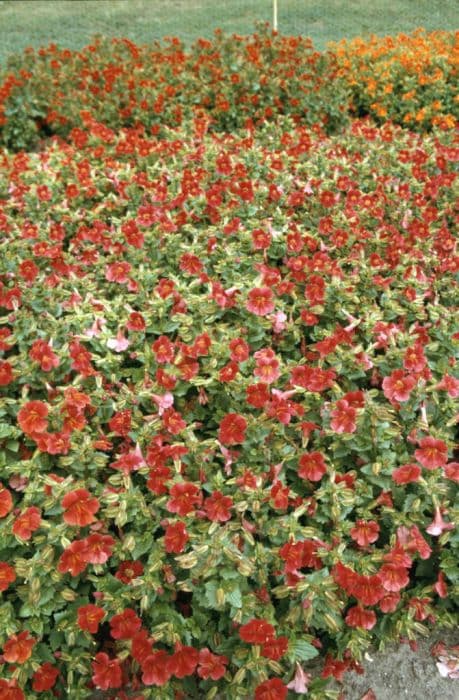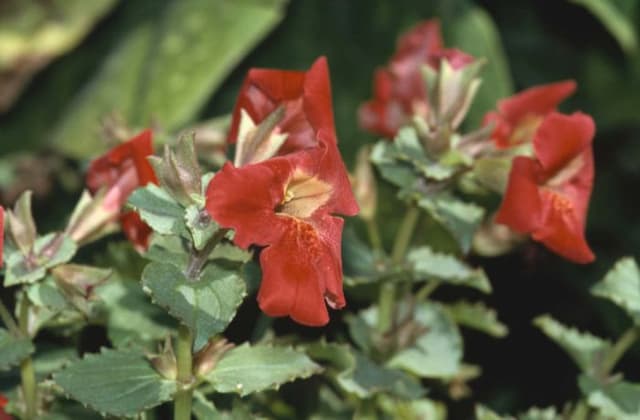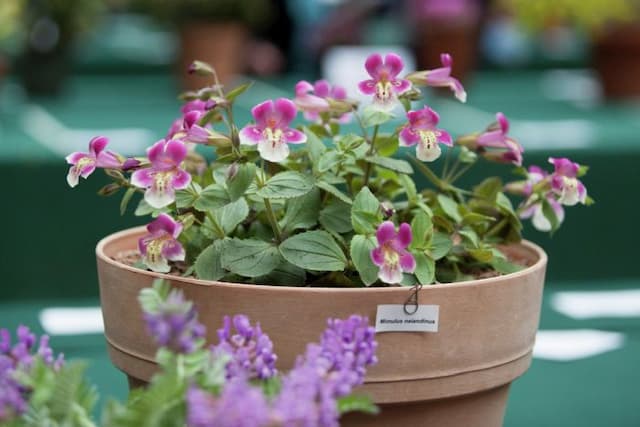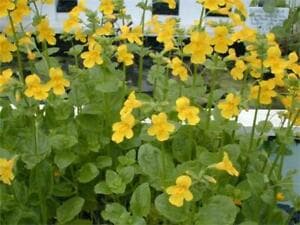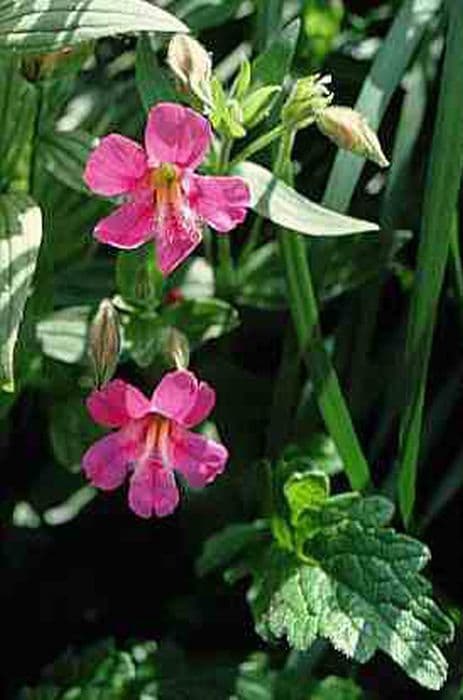Monkeyflower Mimulus guttatus
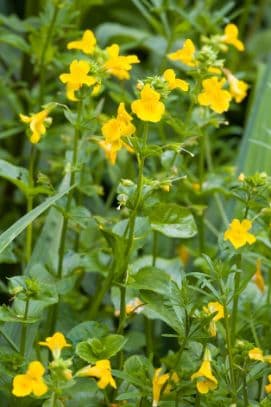
ABOUT
Commonly known as the common monkeyflower, this plant is well-recognized by its unique and captivating flowers. The blossoms are bright yellow, often dotted with red or brown splotches in the throat, which is quite pronounced. These throat spots are a distinct characteristic and are said to be attractive to the plant's pollinators. Each flower is tubular and flares out into a five-lobed mouth, almost like a typical "snapdragon" appearance. These appealing blossoms grow at the end of stems that can host multiple flowers. The foliage of common monkeyflower is generally a lush green, and the leaves are lance-shaped or oblong with smooth or slightly toothed edges. They can be found alternating along the stem, providing a dense green backdrop for the vivid flowers. It is a plant that may also show a slight variation in leaf coloration, ranging from light green to a darker, richer hue. The stems themselves are somewhat upright but they have a tendency to branch and can be sprawling. As a water-loving plant, it tends to grow along the edges of streams and wetlands, which is reflected in its foliage that seems quite at home in moist environments. It's common to see these plants forming clusters or stands in their natural setting, creating patches of bright yellow against the greenery along waterways. The overall impression of the common monkeyflower is one of rustic charm and enduring appeal, a delightful highlight to the banks it often calls home.
About this plant
 Names
NamesFamily
Phrymaceae
Synonyms
Common Monkeyflower, Seep Monkeyflower, Yellow Monkeyflower, Golden Monkeyflower
Common names
Mimulus langsdorffii var. guttatus, Mimulus guttatus var. immaculatus, Mimulus nasutus, Erythranthe guttata, Mimulus luteus var. guttatus
 Toxicity
ToxicityTo humans
The common monkey flower (Mimulus guttatus) is not generally considered toxic to humans. There is no widespread documentation of toxicity from this plant, and it does not typically pose a threat if touched or ingested in small quantities. However, as with any plant, individual allergies or reactions are possible, and it is always a good practice to avoid eating plants unless they are known to be safe and are prepared correctly.
To pets
The common monkey flower (Mimulus guttatus) is not known to be toxic to pets. It is not listed among common poisonous plants for pets such as dogs and cats. As always, it is best practice to prevent pets from consuming plants unnecessarily, as they might have individual sensitivities or reactions to plant materials that are generally considered non-toxic.
 Characteristics
CharacteristicsLife cycle
Perennials
Foliage type
Deciduous
Color of leaves
Green
Flower color
Yellow
Height
1-2 feet (30-60 cm)
Spread
1-2 feet (30-60 cm)
Plant type
Herb
Hardiness zones
6
Native area
North America
Benefits
 General Benefits
General Benefits- Attracts Pollinators: Mimulus guttatus, commonly known as Monkeyflower, is known to attract bees and other pollinators which is beneficial for gardens and ecosystems.
- Erosion Control: Its root system helps stabilize soil, especially in moist environments, which can prevent erosion along streambanks and slopes.
- Aesthetic Value: Monkeyflowers add visual interest to gardens and landscapes with their bright and cheerful yellow flowers.
- Wildlife Habitat: They provide shelter and food for various insects and serve as larval host plants for some butterfly species.
- Wetland Indicator: Monkeyflower can indicate the health of wetland areas as it thrives in these environments, suggesting adequate water levels and quality.
- Education and Research: As a model organism in genetics and ecology studies, Monkeyflower helps scientists understand evolutionary patterns and plant responses to the environment.
 Medical Properties
Medical Properties- Antiseptic: The plant has been traditionally used for its wound-healing and antiseptic properties.
- Anti-inflammatory: Some constituents in the plant may have anti-inflammatory effects.
- Sedative: There are accounts of it being used to help calm nerves and promote relaxation.
 Air-purifying Qualities
Air-purifying QualitiesThis plant is not specifically known for air purifying qualities.
 Other Uses
Other Uses- Mimulus guttatus, known as the common monkeyflower, can be used in ecological studies for understanding rapid evolution in wild populations due to its genetic diversity and adaptability.
- The common monkeyflower serves as an excellent plant for use in education when demonstrating principles of plant biology, genetics, and ecology within classroom settings.
- This plant is often used as a model organism in pollination biology research to understand the interaction between floral traits and pollinator behavior.
- In horticulture, Mimulus guttatus is a choice for water gardens or wet areas in landscaping, providing a bright splash of color where few other flowering plants can thrive.
- The common monkeyflower is utilized in the study of climate change effects, as it can help scientists track changes in flowering time and distribution in response to changing environments.
- This plant is often incorporated in native plant gardens, as it is easy to grow and can help in maintaining local biodiversity.
- In artwork, the vibrant flowers of Mimulus guttatus have been used in pressed flower crafts for creating natural, floral designs.
- The common monkeyflower can be used in riparian restoration projects to prevent soil erosion due to its robust root system that holds soil together along streambanks.
- Study of the plant's response to pathogens can provide insights into plant-disease interactions and potential strategies for crop protection in agriculture.
- Because of its responsiveness to nutrient levels, the common monkeyflower can be used in scientific studies as an indicator species for assessing water quality in freshwater ecosystems.
Interesting Facts
 Feng Shui
Feng ShuiThe Monkeyflower is not used in Feng Shui practice.
 Zodiac Sign Compitability
Zodiac Sign CompitabilityThe Monkeyflower is not used in astrology practice.
 Plant Symbolism
Plant Symbolism- Fearlessness: Mimulus guttatus, commonly known as Monkeyflower, often represents courage and the ability to face one's fears, as its Latin name "Mimulus" is derived from "mimus," meaning mimic or actor, suggesting facing one's role or challenges boldly.
- Playfulness: The Monkeyflower's whimsical appearance, with its grinning, monkey-like flowers, is symbolic of a playful nature and a reminder to enjoy the lighter side of life.
- Adaptability: As a plant that thrives in a wide range of habitats, including wet environments, the Monkeyflower is emblematic of adaptability and the ability to thrive in various conditions.
 Water
WaterThe Monkey Flower, or Mimulus guttatus, prefers consistently moist soil, so water it regularly to maintain even moisture. Depending on the climate and weather conditions, watering every few days might be necessary, especially during dry spells. Typically, applying about 1 to 2 gallons of water per week should suffice, but adjust the amount to avoid standing water, which can lead to root rot. During hot, dry periods, more frequent watering might be required. Always check the top inch of the soil before watering; if it feels dry to the touch, it's time to water.
 Light
LightMonkey Flower thrives in full to partial sunlight. It ideally requires a spot where it can receive direct morning light but is sheltered from the intense afternoon sun, especially in hotter climates. This balance ensures that the Monkey Flower gets enough light without experiencing leaf burn or excess drying out.
 Temperature
TemperatureThe ideal temperature for Monkey Flower ranges between 60 to 75 degrees Fahrenheit. It can tolerate a minimum temperature down to about 32 degrees Fahrenheit and a maximum temperature of around 90 degrees Fahrenheit. However, for optimal growth and flowering, try to maintain the temperature closer to the ideal range and protect the plant from extreme temperatures.
 Pruning
PruningPruning Monkey Flower is necessary to promote bushier growth and more blooms. Pinch back the tips of the stems in the spring to encourage branching. Additionally, deadheading spent flowers throughout the blooming season can stimulate further flowering. Prune the plant after the main bloom period or as needed to maintain its shape and remove any damaged or leggy growth.
 Cleaning
CleaningAs needed
 Soil
SoilThe best soil mix for Monkey Flower (Mimulus guttatus) is a well-draining, loamy soil with a pH around 6.0 to 7.5. A mixture of peat, sand, and garden soil can achieve this, and incorporating organic matter like compost will help to ensure the soil remains fertile and retains moisture without becoming waterlogged.
 Repotting
RepottingMonkey Flower does not frequently need repotting as it can often be treated as an annual. However, if grown as a perennial, repotting every 2-3 years or when the plant appears to outgrow its container will be sufficient to maintain its health.
 Humidity & Misting
Humidity & MistingMonkey Flower thrives in moderate to high humidity levels. While it can adapt to average household humidity, ensuring humidity levels of around 50-70% will mimic its natural damp habitat and support its growth.
 Suitable locations
Suitable locationsIndoor
Ensure bright indirect light and keep the soil moist for indoor Monkey Flower.
Outdoor
Plant in part shade, keep soil moist and protect from hot, dry conditions for outdoor Monkey Flower.
Hardiness zone
3-9 USDA
 Life cycle
Life cycleMimulus guttatus, commonly known as common monkeyflower, begins its life cycle with seed germination, typically occurring in moist soils along streams and wetlands. The seedlings quickly grow into herbaceous plants, producing simple, opposite leaves along their stems. During its vegetative stage, the plant focuses on accumulating resources and increasing its biomass. Upon reaching maturity, the monkeyflower produces vibrant yellow, bilaterally symmetrical flowers which are capable of self-pollination as well as cross-pollination through insect visitors. After successful pollination, the flowers develop into capsules containing numerous tiny seeds. The plant completes its life cycle when these seeds are dispersed into the environment, often by water, enabling the growth of new individuals.
 Propogation
PropogationPropogation time
Spring-Early Summer
The most popular method for propagating Mimulus guttatus, commonly known as the common monkeyflower or seep monkeyflower, is by seed. Seeds can be sown in spring after the danger of frost has passed or started indoors about 6 to 8 weeks before the last expected frost. To ensure a higher success rate, it's best to surface sow the fine seeds on moist, well-draining soil, as they require light for germination. They should be kept at around 70°F (approximately 21°C) and usually germinate within 10 to 20 days. Care must be taken to not cover the seeds with soil, instead lightly pressing them into the soil surface ensures they have the contact they need without obstructing light. Regular misting is required to keep the soil damp but not waterlogged during the germination period. Once seedlings emerge and develop their first set of true leaves, they can be transplanted into individual pots or outdoor locations.
